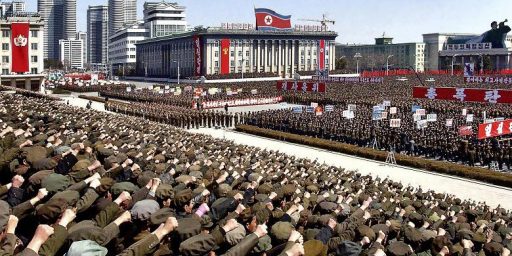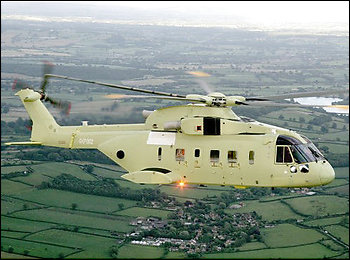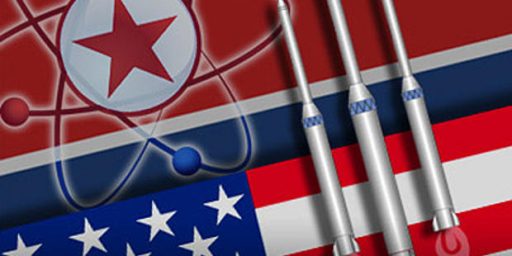ARMY READINESS
WaPo gives a lot of play to a non-story:
Four Army divisions — 40 percent of the active-duty force — will not be fully combat-ready for up to six months next year, leaving the nation with relatively few ready troops in the event of a major conflict in North Korea or elsewhere, a senior Army official said yesterday.
The four divisions — the 82nd Airborne, the 101st Airborne, the 1st Armored and the 4th Infantry — are to return from Iraq next spring, to be replaced by three others, with a fourth rotating into Afghanistan. That would leave only two active-duty divisions available to fight in other parts of the world.
Briefing reporters at the Pentagon, the official said the four returning divisions will be rated either C-3 or C-4, the Army’s two lowest readiness categories, for 120 to 180 days after they return as vehicles and helicopters are overhauled and troops are rested and retrained.
C-3 means a division is capable of performing only some of its combat missions, and C-4 means a division needs additional manpower, training or equipment to fight a major regional war.
A fifth division, the 3rd Infantry, which returned from Iraq in August, is still not fully ready to return to combat, the official said.
While the Army had been using 120 days as its standard for “resetting” divisions returning from overseas deployments, overhauling the divisions returning from Iraq could take as long as 180 days because of the extreme weather in Iraq and the unprecedented magnitude of the planned troop rotation.
The four returning divisions will bring 650 helicopters, 5,700 tanks and other tracked vehicles and 46,000 wheeled vehicles with them, the official said. “This is not Hertz rent-a-car, where you drive [vehicles] for two years and you get rid of the fleet,” he said. “We have to take good care of our tanks . . . and all the other equipment. Because we don’t get to buy new.”
Once those divisions return from Iraq, Army readiness will be at its lowest point since the end of the 1991 Persian Gulf War. Since then, Army officials have tried to keep divisions at the highest, C-1 readiness level.
These are bureaucratic ratings, not measures of actual combat strength. When troops rotate home from major deployments, a lot of vehicles get general support overhauls, soldiers take leave, and so forth. But could they go to war and win tomorrow? Absolutely.
Military analysts differ over the significance of divisions scoring low on the Army’s readiness rating system.
Retired Gen. Barry R. McCaffrey, a former division commander and staunch advocate of more Army forces, said four to five divisions below the C-1 rating “means literally half the Army is broken and not ready to fight.”
“We have a potential huge challenge from North Korea,” McCaffrey said. “So by definition, at this point, we would only be able to respond to an emergency in North Korea with air and naval power or nuclear weapons. It’s an unacceptable, in my judgment, strategic risk.”
Michael O’Hanlon, a defense analyst at the Brookings Institution who has written extensively about readiness, said the Army’s system for gauging readiness is suspect and should not be overemphasized.
Although overhauling 650 helicopters used in Iraq will be a lengthy process, O’Hanlon acknowledged, the job of resetting four divisions back from Iraq would at most delay the Army’s ability to respond to a major provocation by North Korea by a month or two.
“It’s sort of like the New York Yankees in January,” O’Hanlon said. “Their readiness is lower because they haven’t gone back to spring training. But they’re still a damn good baseball team.”






The real issue is not personnel readiness, its vehicle and equipment readiness. An awful lot of the logistics vehicles will wind up being coded out, and almost certainly a sigificant number of combat vehicles. No few weapons, too.
Interesting. We really didn’t have any issues coming back from Saudi in ’91. Granted, this mission has been longer but the combat ops weren’t. But I could see where the log vehicles would have put on a lot of miles.
While I suspect O’Hanlan was pulling that figure (delay the Army’s ability to respond… by a month or two) out of the air, when it comes to Korea, a month or two is a long time. The whole length of South Korea is under 400 miles long; in the Korean War, it was just over a month from invasion to the retreat to the Pusan perimeter.
Of course, when the Communists invaded in 1950, we weren’t as prepared to fight, and the South Koreans didn’t have anything resembling the military they have today. No question, a war on the peninsula would be devastating for both North and South, but that may be the strongest parallel between the 1950s and a notional conflict today.
—